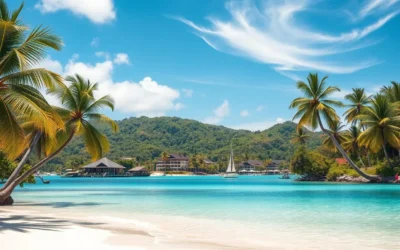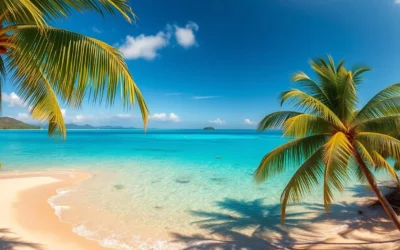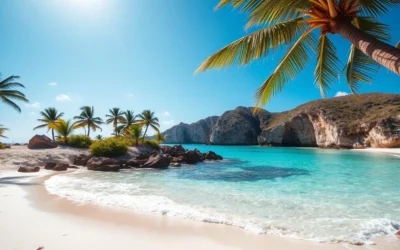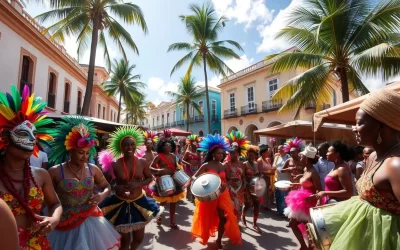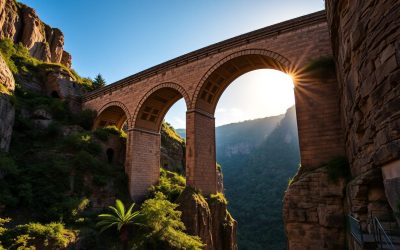Did you know that Indian Town National Park in Antigua and Barbuda is home to one of the Caribbean’s most remarkable natural wonders? Devil’s Bridge, a limestone arch sculpted by Atlantic waves over thousands of years, stands as a testament to nature’s artistic power. This geological marvel isn’t just beautiful—it holds a poignant history tied to the island’s colonial past, where desperate enslaved people reportedly leapt into the churning waters below.
The iconic Devil’s Bridge at Indian Town National Park, formed by thousands of years of wave erosion
Overview of Indian Town National Park’s Natural Heritage
Located on Antigua’s northeastern coast, Indian Town National Park showcases the island’s raw natural beauty. This protected area is a biodiversity hotspot where dramatic limestone formations meet the powerful Atlantic Ocean, creating a landscape unlike anywhere else in the Caribbean.
The park’s unique ecosystem supports diverse plant and animal life, from resilient coastal vegetation to a variety of bird species that thrive in this rugged environment. As one of Antigua’s most significant natural reserves, it offers visitors a glimpse into the geological and ecological processes that have shaped the island over millennia.
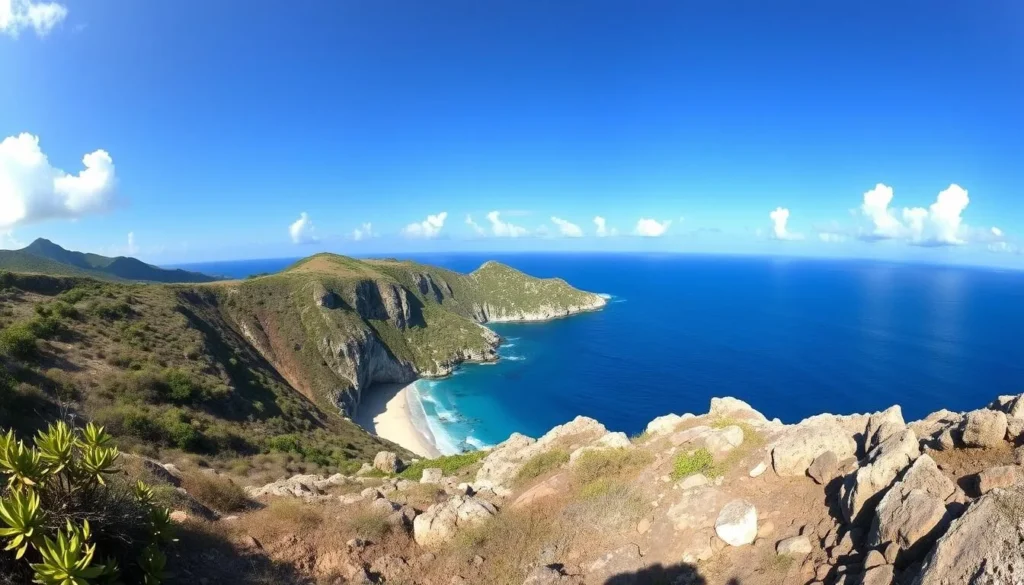
The dramatic coastline of Indian Town National Park where limestone cliffs meet the Atlantic Ocean
Geographic Location and Formation
Indian Town National Park sits on the eastern edge of Antigua, where the Caribbean island faces the full force of the Atlantic Ocean. This strategic position has played a crucial role in shaping the park’s distinctive landscape over millions of years.
The area’s limestone bedrock, formed from ancient coral reefs, has been continuously sculpted by powerful waves and weather. This ongoing process has created the park’s signature features, including caves, blowholes, and most famously, Devil’s Bridge—a natural limestone arch that has become the park’s iconic centerpiece.
Ready to explore Indian Town National Park?
Start planning your Antigua adventure today with these essential travel resources.
Ecological Significance
Despite its relatively small size, Indian Town National Park plays a vital role in preserving Antigua’s natural heritage. The park protects several distinct habitats, from windswept coastal areas to more sheltered inland sections, each supporting specialized plant and animal communities.
The park’s flora has adapted to thrive in challenging conditions, with salt-resistant species dominating the coastline. This unique ecosystem provides important habitat for numerous bird species, including frigatebirds and brown pelicans that can often be spotted soaring above the dramatic landscape.
Climate and Best Time to Visit
Indian Town National Park experiences a tropical climate typical of the Caribbean, with warm temperatures year-round. However, its position on Antigua’s Atlantic coast means it receives stronger winds and slightly different weather patterns than the island’s more sheltered western side.
The best time to visit is during Antigua’s dry season, from December to April, when you’ll enjoy sunny days with lower humidity—perfect for exploring the park’s trails and viewpoints. The summer months (May to November) bring higher temperatures, increased humidity, and a greater chance of rain, though morning visits can still be pleasant.
“The natural geological features of Indian Town National Park are truly awe-inspiring, showcasing the raw power and beauty of Antigua’s landscape.”
Getting to Indian Town National Park: Transportation and Access
Reaching Indian Town National Park is relatively straightforward, with several transportation options available depending on your preferences and budget. The park is located approximately 30 minutes from St. John’s, Antigua’s capital city, and about 45 minutes from V.C. Bird International Airport.
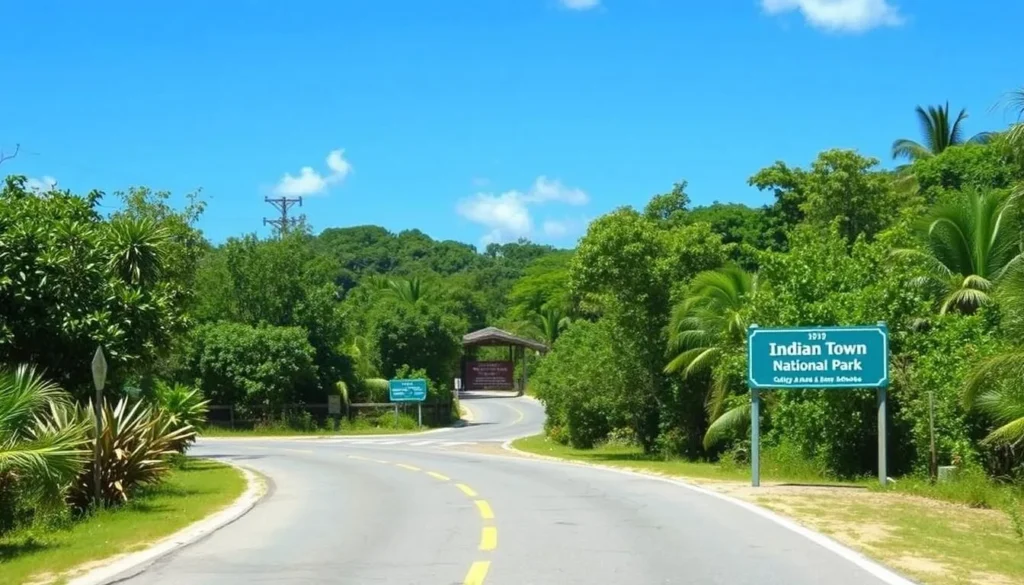
The road approach to Indian Town National Park, showing clear signage and surrounding vegetation
Rental Cars and Driving Directions
Renting a car gives you the most flexibility to explore Indian Town National Park and other attractions around Antigua at your own pace. Several rental agencies operate at the airport and in St. John’s, offering a range of vehicles to suit different budgets.
To reach the park, follow the main road east from St. John’s toward Long Bay. Look for signs to Devil’s Bridge and Indian Town National Park as you approach the northeastern coast. The roads are generally well-maintained, though some sections near the park entrance may be slightly rough.
Explore Antigua at your own pace
Rent a car and discover Indian Town National Park and beyond on your schedule.
Guided Tours and Taxis
If you prefer not to drive, numerous tour operators offer excursions to Indian Town National Park, often combined with other attractions in eastern Antigua. These guided tours provide valuable insights into the park’s natural features and cultural significance.
Alternatively, taxis are readily available throughout Antigua and can take you directly to the park. Consider arranging for your driver to wait or return at a specified time, as taxis are less frequent in this area of the island.
| Transportation Option | Travel Time from St. John’s | Travel Time from Airport | Approximate Cost |
| Rental Car | 30 minutes | 45 minutes | $50-80 per day |
| Taxi | 30 minutes | 45 minutes | $25-40 one way |
| Guided Tour | 30 minutes | 45 minutes | $50-100 per person |
Public Transportation
While public buses operate throughout Antigua, service to Indian Town National Park is limited. If you’re on a tight budget, you can take a bus from St. John’s toward Long Bay and then walk the remaining distance or arrange a short taxi ride to the park entrance.
Natural Wonders and Geological Features
Indian Town National Park is renowned for its spectacular geological formations, shaped by millions of years of interaction between limestone rock and the powerful Atlantic Ocean. These natural wonders offer visitors a fascinating glimpse into the forces that continue to sculpt Antigua’s dramatic eastern coastline.
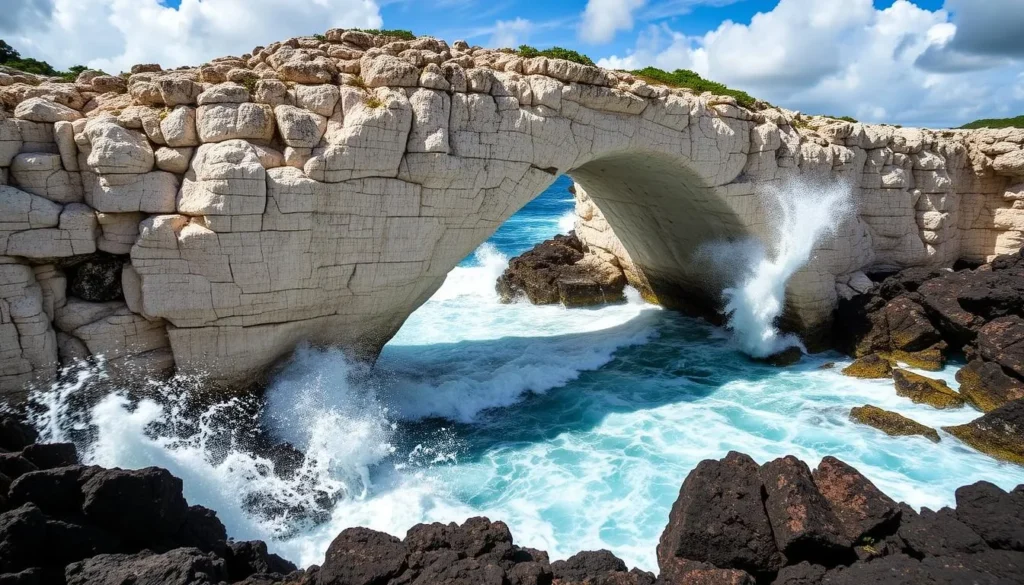
Devil’s Bridge stands as the park’s most iconic geological formation, showcasing nature’s sculptural power
Devil’s Bridge: The Iconic Natural Arch
The crown jewel of Indian Town National Park is undoubtedly Devil’s Bridge, a natural limestone arch formed by thousands of years of wave erosion. This remarkable formation stretches across a section of coastline where the Atlantic Ocean’s powerful waves have carved through the softer parts of the limestone, leaving the stronger section intact as a bridge.
Beyond its geological significance, Devil’s Bridge holds cultural and historical importance. During Antigua’s colonial period, it’s said that enslaved people would jump from the bridge into the turbulent waters below, giving rise to its ominous name. Today, it stands as both a natural wonder and a somber reminder of the island’s complex past.
Safety Alert: Never attempt to walk across Devil’s Bridge, especially during high tide or rough seas. The limestone surface is extremely slippery, and powerful waves can sweep visitors into dangerous waters. Observe this natural wonder from a safe distance.
Coastal Blowholes and Wave Action
Throughout Indian Town National Park, the interaction between waves and limestone has created impressive blowholes—natural features where water is forced through narrow openings in the rock, creating spectacular water spouts during high tide or rough seas.
These blowholes demonstrate the ongoing power of erosion that continues to shape the park’s landscape. The best time to witness their dramatic displays is during periods of stronger wave activity, typically during winter months or when weather systems bring larger swells to Antigua’s eastern coast.
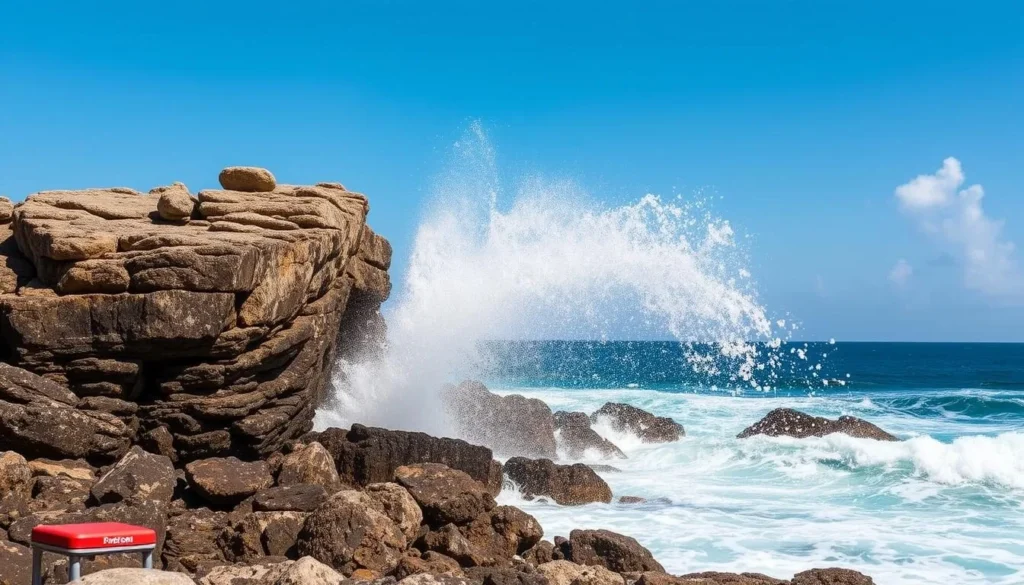
A coastal blowhole erupts with spray as Atlantic waves force water through narrow channels in the limestone
Limestone Caves and Formations
The park features several limestone caves and unique rock formations that showcase the diverse effects of erosion. These caves, carved by a combination of wave action and rainfall over centuries, provide fascinating glimpses into the geological processes that continue to shape Antigua’s coastline.
Exploring these formations offers photographers exceptional opportunities to capture the interplay of light, shadow, and texture in these natural sculptures. The varying colors of the limestone—from bright white to warm amber and dark gray—create striking contrasts against the deep blue of the Atlantic Ocean.
Hiking Trails and Walking Routes
Indian Town National Park offers several hiking trails that allow visitors to experience its dramatic coastal scenery and unique geological features up close. These paths range from easy walks suitable for all fitness levels to more challenging routes that reward hikers with spectacular viewpoints and hidden gems.
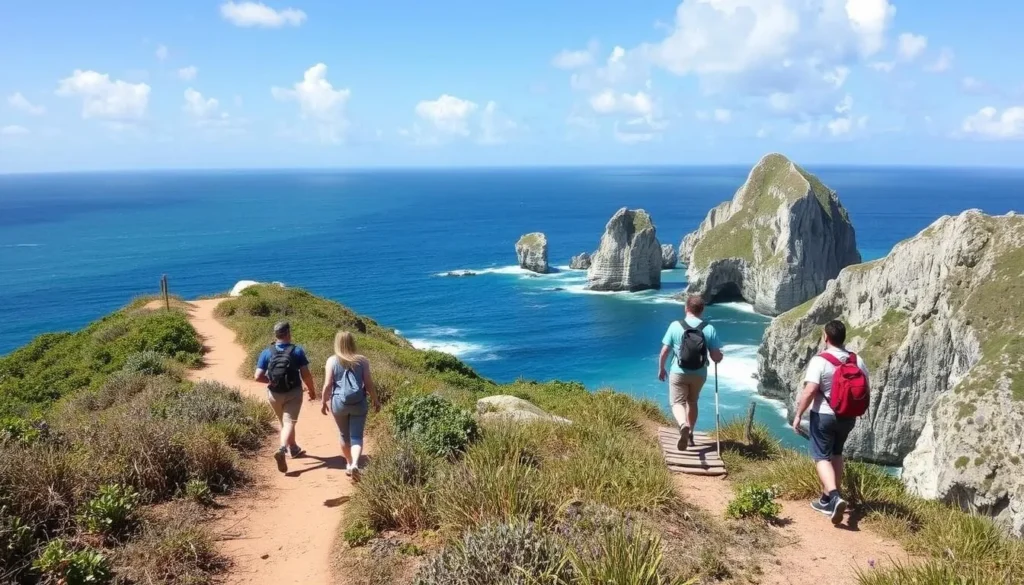
Hikers enjoying the coastal trail at Indian Town National Park with stunning ocean views
Indian Town Trail: The Main Route
The primary path through the park is the Indian Town Trail, a moderately challenging route approximately 2 kilometers (1.2 miles) in length. This well-marked trail takes you through diverse coastal landscapes, offering excellent views of the Atlantic Ocean and opportunities to observe local plant and animal life.
Starting near the park entrance, the trail winds along the coastline, passing several viewpoints before reaching Devil’s Bridge. Along the way, interpretive signs provide information about the park’s geological features and cultural history, enhancing your understanding of this unique environment.
Experience Indian Town National Park with a local guide
Enhance your visit with expert knowledge about the park’s natural wonders and hidden gems.
Coastal Viewpoint Trails
Several shorter side trails branch off from the main path, leading to spectacular coastal viewpoints. These trails vary in difficulty, with some requiring careful footing on uneven terrain, but all offer rewarding panoramas of the rugged coastline and powerful Atlantic waves.
The Blowhole Overlook Trail is particularly popular, taking hikers to an elevated position where they can safely observe the dramatic water displays from coastal blowholes. This 3-kilometer (1.9-mile) route is moderately challenging but manageable for most visitors with proper footwear.
| Trail Name | Distance | Difficulty Level | Highlights | Estimated Time |
| Indian Town Trail | 2 km (1.2 miles) | Moderate | Coastal views, Devil’s Bridge, native flora | 1-1.5 hours |
| Blowhole Overlook Trail | 3 km (1.9 miles) | Moderate | Coastal blowholes, panoramic vistas | 1.5-2 hours |
| Limestone Caves Trail | 4 km (2.5 miles) | Challenging | Limestone formations, geological wonders | 2-3 hours |
Hiking Tips and Essentials
When hiking in Indian Town National Park, proper preparation is essential for a safe and enjoyable experience. The coastal environment can be challenging, with strong sun, wind, and occasionally slippery terrain requiring appropriate gear and precautions.
What to Bring:
- Sturdy hiking shoes with good traction
- Sun protection (hat, sunscreen, sunglasses)
- Plenty of water (at least 1 liter per person)
- Light snacks for energy
- Camera for capturing the scenery
Safety Considerations:
- Stay on marked trails at all times
- Keep a safe distance from cliff edges
- Never hike alone in remote areas
- Check weather conditions before starting
- Inform someone of your hiking plans

Trail map of Indian Town National Park showing the main hiking routes and points of interest
Best Things to Do at Indian Town National Park
Beyond hiking, Indian Town National Park offers a variety of activities that allow visitors to experience its natural beauty and cultural significance. Whether you’re interested in photography, wildlife watching, or simply soaking in the dramatic coastal scenery, the park provides numerous opportunities for memorable experiences.
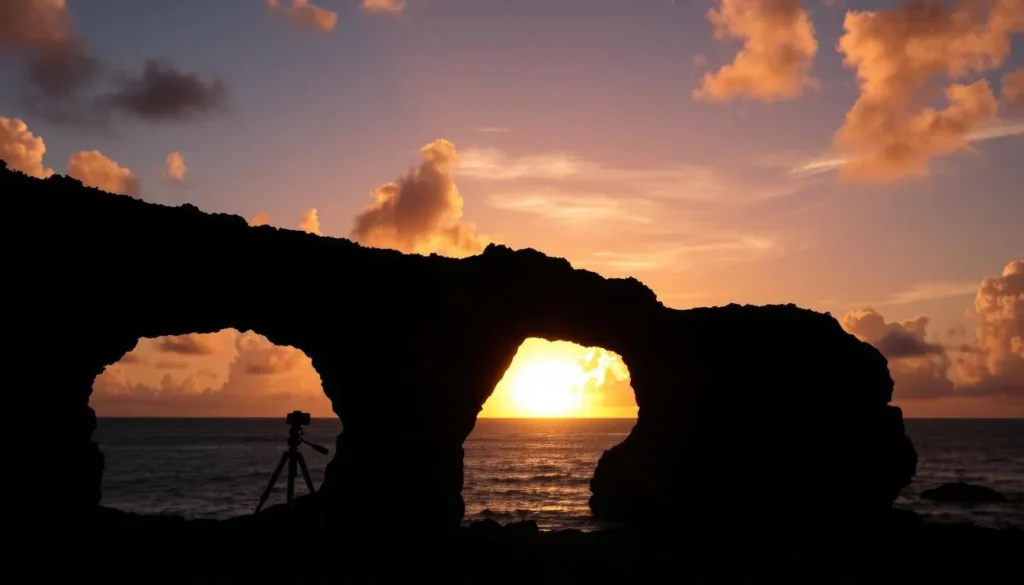
A photographer captures the dramatic sunrise light at Devil’s Bridge, one of the park’s prime photography locations
Scenic Photography Opportunities
Indian Town National Park is a paradise for photography enthusiasts, offering dramatic landscapes, unique geological formations, and ever-changing light conditions. The contrast between rugged limestone, powerful ocean waves, and tropical vegetation creates compelling compositions at every turn.
For the best photography conditions, visit during the golden hours of early morning or late afternoon when the low-angle sunlight brings out the textures and colors of the landscape. Devil’s Bridge is particularly photogenic at sunrise, when the first light illuminates the natural arch against the backdrop of the Atlantic Ocean.
Photography Tip: Bring a polarizing filter for your camera to reduce glare from the ocean and enhance the colors of the sky and water. A tripod is also recommended for low-light conditions and to capture the motion of waves with longer exposures.
Wildlife Watching
The park’s diverse habitats support a variety of wildlife, particularly birds that thrive in coastal environments. Bring binoculars to spot frigatebirds, brown pelicans, and various seabirds soaring above the coastline or resting on rocky outcrops.
During the winter months (December to April), keep an eye on the ocean horizon for possible whale sightings, as humpback whales migrate through Caribbean waters during this period. The park’s elevated viewpoints provide excellent vantage points for spotting these magnificent marine mammals.

Frigate birds soar above the coastline of Indian Town National Park, adding to the area’s natural beauty
Cultural and Historical Exploration
Indian Town National Park offers opportunities to connect with Antigua’s cultural heritage and complex history. The name “Indian Town” refers to the area’s past inhabitants—indigenous Arawak people who lived here long before European colonization.
Throughout the park, interpretive displays provide insights into both the indigenous history and the later colonial period, including the somber stories associated with Devil’s Bridge. Taking time to read these materials adds depth to your visit, helping you understand the human connections to this dramatic landscape.
| Activity | Best Time | Location in Park | Equipment Needed |
| Photography | Sunrise or late afternoon | Devil’s Bridge, coastal viewpoints | Camera, tripod, polarizing filter |
| Wildlife Watching | Early morning | Coastal trails, elevated viewpoints | Binoculars, telephoto lens |
| Cultural Exploration | Any time | Throughout the park | Guidebook, interpretive materials |
Make the most of your Antigua vacation
Find the perfect place to stay near Indian Town National Park.
Flora and Fauna Highlights
Despite its rugged appearance, Indian Town National Park supports a surprising diversity of plant and animal life adapted to the challenging coastal conditions. The park’s unique ecosystem showcases the resilience of Caribbean wildlife in the face of strong winds, salt spray, and limited freshwater.

Sea grape trees and other salt-tolerant vegetation thrive along the park’s windswept coastline
Coastal Plant Adaptations
The plant life in Indian Town National Park has evolved remarkable adaptations to survive in this harsh environment. Salt-resistant species dominate the landscape, with specialized features that allow them to thrive despite constant exposure to ocean spray and strong winds.
Sea grape trees (Coccoloba uvifera) are among the most visible plants, recognizable by their large, round leaves and grape-like fruit clusters. Their extensive root systems help stabilize the soil, while their thick, waxy leaves protect against salt and water loss. Other notable species include various succulents, coastal grasses, and wind-sculpted shrubs that form the backbone of the park’s vegetation.
Bird Life and Marine Creatures
The park serves as an important habitat for numerous bird species, particularly those adapted to coastal environments. Frigatebirds are frequently spotted soaring overhead, using their impressive wingspan to ride thermal currents above the cliffs. Brown pelicans, gulls, and various terns also make regular appearances, diving for fish in the waters surrounding the park.
In the tidal pools and shallow waters along the coastline, visitors can observe a variety of marine life, including colorful crabs, small fish, and sea urchins. These miniature ecosystems provide fascinating glimpses into the interconnected web of life that thrives in the transition zone between land and sea.
Common Birds:
- Magnificent Frigatebird
- Brown Pelican
- Royal Tern
- Laughing Gull
- Bananaquit
Marine Life:
- Sally Lightfoot Crabs
- Sea Urchins
- Tide Pool Fish
- Hermit Crabs
- Various Mollusks
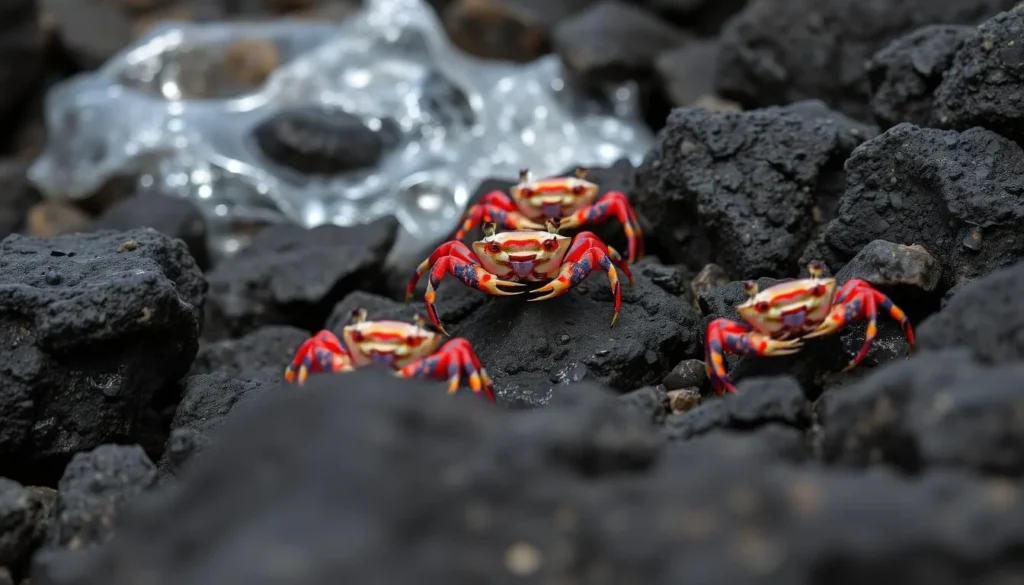
Colorful Sally Lightfoot crabs are among the marine creatures that can be spotted along the park’s rocky shoreline
Conservation Efforts
Indian Town National Park plays an important role in Antigua’s conservation efforts, protecting both the unique geological features and the biodiversity they support. The park’s protected status helps preserve this ecosystem for future generations while allowing sustainable tourism that raises awareness about the importance of coastal conservation.
Visitors can contribute to these conservation efforts by following park guidelines, staying on designated trails, and avoiding any activities that might disturb wildlife or damage sensitive habitats. By practicing responsible tourism, you help ensure that Indian Town National Park remains a vibrant natural sanctuary for years to come.
Safety Tips and Visitor Guidelines
While Indian Town National Park offers extraordinary natural beauty, it also presents certain hazards that visitors should be aware of. Following these safety guidelines will help ensure a positive experience while protecting both yourself and the park’s fragile ecosystem.
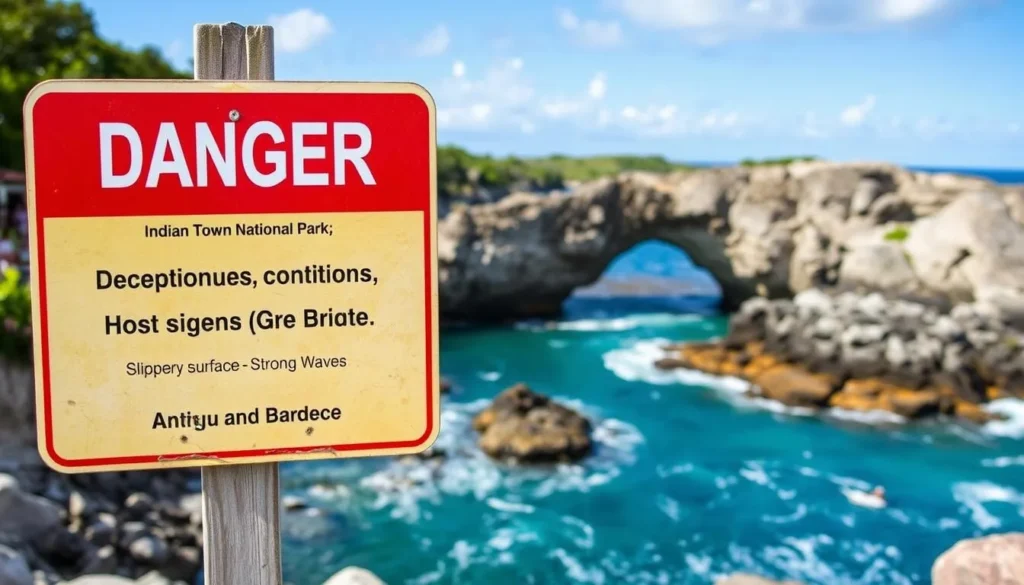
Warning signs at Devil’s Bridge caution visitors about the dangers of crossing the natural formation
Coastal Safety Precautions
The dramatic coastal landscape that makes Indian Town National Park so appealing also creates potential dangers. Strong waves, slippery surfaces, and unstable cliff edges require visitors to exercise caution throughout the park, especially in the following areas:
Critical Safety Information:
- Never attempt to walk across Devil’s Bridge, regardless of how dry or stable it appears
- Keep a safe distance from cliff edges, which may be undercut and unstable
- Stay back from blowholes, which can erupt unexpectedly with powerful water spray
- Be aware of wave patterns and avoid areas where waves are breaking onto shore platforms
- Exercise extra caution during high tide or when seas are rough
Environmental Protection Guidelines
Indian Town National Park’s ecosystem is sensitive to human impact. Visitors play an important role in preserving this natural treasure by following these environmental guidelines:
- Stay on designated trails to prevent erosion and protect vegetation
- Take all trash with you when leaving the park
- Do not collect rocks, plants, or other natural materials
- Observe wildlife from a distance without disturbing their natural behaviors
- Keep noise levels low to avoid disrupting wildlife and other visitors
Practical Visitor Information
Being prepared for your visit to Indian Town National Park will enhance your experience and help you avoid common issues. Consider these practical tips when planning your trip:
What to Bring:
- Plenty of water (no drinking water available in the park)
- Sun protection (hat, sunscreen, sunglasses)
- Sturdy walking shoes with good traction
- Light rain jacket or windbreaker
- Camera and binoculars
Park Information:
- Open daily from sunrise to sunset
- No entrance fee (as of publication date)
- Limited facilities (no restrooms or food services)
- Cell phone coverage may be spotty in some areas
- Allow 2-3 hours for a complete visit
“Preserving the natural wonders of Indian Town National Park is a shared responsibility. By respecting the environment and following safety guidelines, visitors can create an unforgettable and sustainable experience.”
Ready for your Antigua adventure?
Start planning your trip to Indian Town National Park today.
Where to Stay Near Indian Town National Park
While there are no accommodations within Indian Town National Park itself, visitors can choose from several excellent options in the surrounding area. From luxury resorts to boutique guesthouses, eastern Antigua offers lodging choices to suit various preferences and budgets.
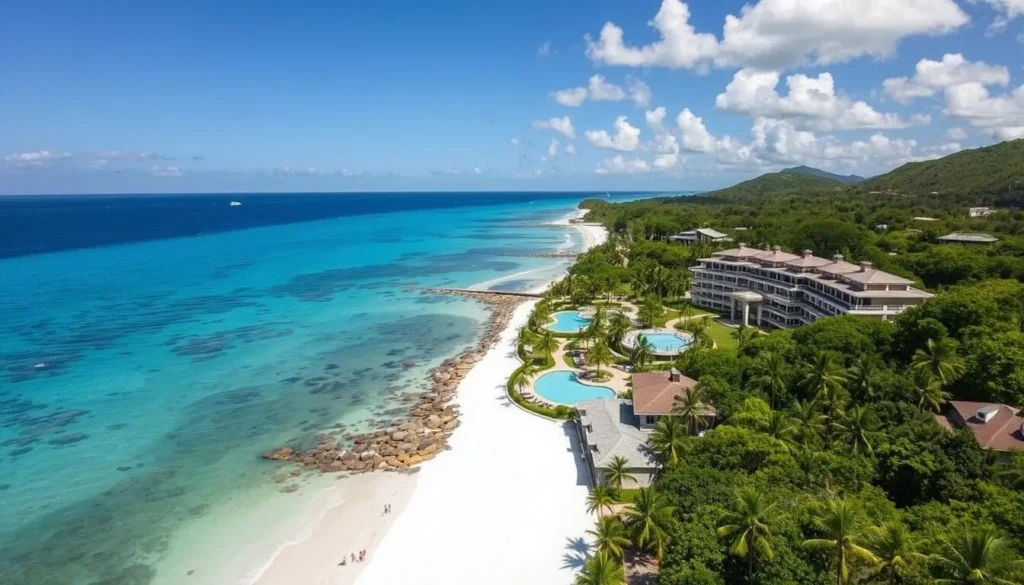
Beachfront resorts near Indian Town National Park offer comfortable accommodations with stunning ocean views
Nearby Luxury Resorts
For travelers seeking premium accommodations, several upscale resorts are located within a 15-30 minute drive of Indian Town National Park. These properties typically offer comprehensive amenities including swimming pools, restaurants, spa services, and organized activities.
The Verandah Resort & Spa and Pineapple Beach Club are popular choices in the area, providing all-inclusive options with beautiful settings along Antigua’s northeastern coastline. These resorts make excellent bases for exploring the park while enjoying luxury amenities during your stay.
Boutique Hotels and Guesthouses
Visitors preferring a more intimate lodging experience can choose from several boutique hotels and guesthouses in nearby communities. These smaller properties often provide a more personalized experience and opportunities to connect with local culture.
Look for accommodations in the Long Bay area or the village of Freetown, both offering convenient access to Indian Town National Park. These options typically provide good value while still offering comfortable rooms and basic amenities like Wi-Fi and air conditioning.
| Accommodation Type | Distance from Park | Price Range | Amenities |
| Luxury Resorts | 10-20 minutes | $$$-$$$$ | All-inclusive options, pools, restaurants, spas |
| Boutique Hotels | 5-15 minutes | $$-$$$ | Personalized service, local character, restaurants |
| Guesthouses | 5-10 minutes | $-$$ | Basic comforts, authentic experience, value |
Vacation Rentals
For families or groups seeking more space and self-catering options, vacation rentals provide an excellent alternative to traditional accommodations. Eastern Antigua offers a variety of rental properties, from beachfront villas to cozy apartments, many within easy driving distance of Indian Town National Park.
These rentals often provide amenities like full kitchens, multiple bedrooms, and private outdoor spaces, allowing for a more independent and flexible vacation experience. Many also offer stunning views of the Atlantic coastline that complement your park visit.
Find your perfect stay in Antigua
Browse accommodations near Indian Town National Park for every budget and preference.
Conclusion: Experiencing the Natural Wonder of Indian Town National Park
Indian Town National Park stands as one of Antigua’s most remarkable natural treasures, offering visitors a powerful glimpse into the raw beauty and geological wonders of the Caribbean. From the iconic Devil’s Bridge to the dramatic coastal landscapes shaped by millions of years of Atlantic waves, this protected area provides unforgettable experiences for nature lovers, photographers, and adventure seekers alike.
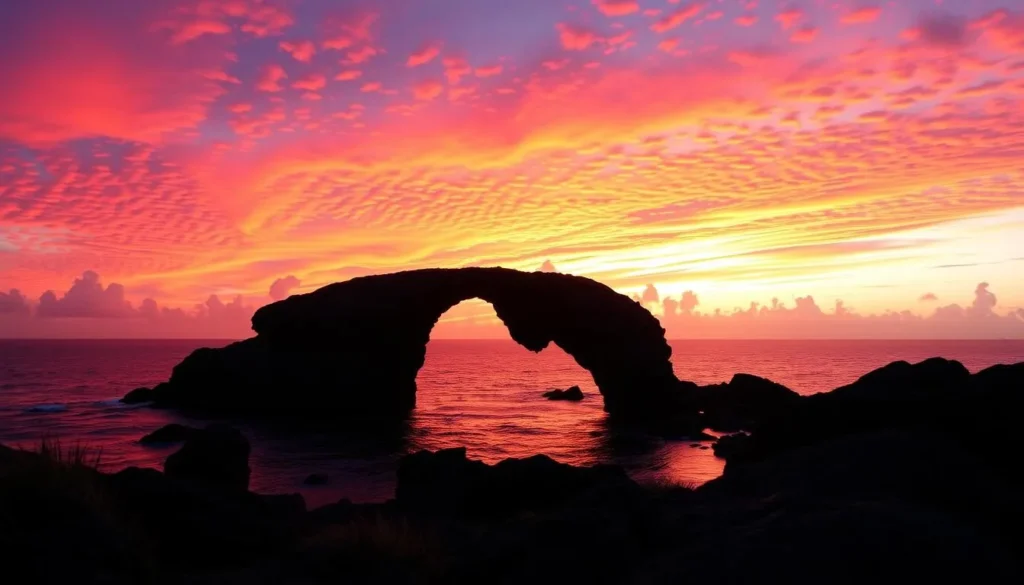
Sunset casts a golden glow over Indian Town National Park, creating a magical end to a day of exploration
As you plan your visit to this extraordinary destination, remember that the park’s beauty comes with responsibility—both for your safety and for the preservation of its delicate ecosystem. By following the guidelines outlined in this guide, you’ll help ensure that Indian Town National Park remains a pristine natural wonder for generations to come.
Whether you’re captivated by the geological marvels, enchanted by the diverse wildlife, or simply seeking a peaceful connection with nature, Indian Town National Park offers a uniquely Antiguan experience that showcases the island beyond its famous beaches. This windswept corner of paradise invites you to discover the powerful forces that have shaped both the land and its history, leaving you with memories that will last long after your Caribbean adventure ends.
Ready to explore Indian Town National Park?
Start planning your Antigua adventure today!
The above is subject to change.
Check back often to TRAVEL.COM for the latest travel tips and deals.

